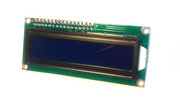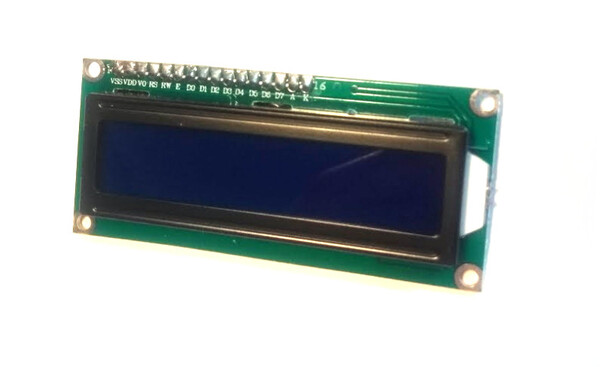
HD44780 Character LCD
Almost all character LCDs currently available are compatible with the HD44780 driver IC. It can work in either 8 or 4 bit modes, however most microcontrollers choose to save IO by using the 4 bit mode.
Support for this display is included in the HD44780 (About Modules) module.
Simple Example
I2C
If you have one of the LCDs with an I2C backpack (containing a PCF8574 8 bit IO expander), just use connect it to I2C with 2 pullup resistors, and use the following example:
I2C1.setup({scl:B6, sda:B7});
var lcd = require("HD44780").connectI2C(I2C1);
lcd.print("Hello World!");
If you have I2C errors, check the address:
Addresses
The default I2C device address in the Espruino module is 0x27, however:
- Many devices have jumpers that allow you to configure the bottom 3 bits of the address (eg.
0x20to0x27) - PCF8574AT based IO expanders default to address
0x3F
To change the address just specify it as second parameter to connectI2C:
require("HD44780").connectI2C(I2C1, 0x3F);
Parallel

Otherwise if you're using the normal parallel interface try the following connections:
| LCD | Function | Espruino |
|---|---|---|
| 1 VSS | GND | GND |
| 2 VDD | VCC | Bat (5V) |
| 3 VO | Contrast | GND or variable resistor |
| 4 RS | RS | A0 |
| 5 RW | RW | GND |
| 6 E | EN | A1 |
| 7 D0 | D0 | - |
| 8 D1 | D1 | - |
| 9 D2 | D2 | - |
| 10 D3 | D3 | - |
| 11 D4 | D4 | C0 |
| 12 D5 | D5 | C1 |
| 13 D6 | D6 | C2 |
| 14 D7 | D7 | C3 |
| 15 A | LED + | Bat |
| 16 K | LED - | GND (5V) |
Note: Pin 1 is usually the pin nearest the corner. If in doubt and your LCD has no markings it's usually pretty easy to see the big PCB trace for GND on one side, and the two wires going to the LED backlight on the other.
And code:
// rs,en,d4,d5,d6,d7
var lcd = require("HD44780").connect(A0,A1,C0,C1,C2,C3);
lcd.print("Hello World!");
However, none of the pins used need special functions, so you should be able to use any of Espruino's pins.
Other
If your display is connected in some other way, you can specify your own write function:
function writeFn(data, cmd) {
// data is a number from 0..255
// cmd is 1 for a command, 0 or undefined for data
}
var lcd = new require("HD44780").HD44780(writeFn);
Troubleshooting
- If you get I2C errors, check the device address, and if you're using hardware I2C you may need pullup resistors
- No errors, but no text? The display needs to be powered from 5v, not 3.3v
- Still no text? Many I2C displays come with a small potentiometer on the back that adjusts contrast - this may need moving to ensure something gets displayes.
Printing an Analog value every second
// var lcd = ... from simple example above ...
function showData() {
lcd.clear();
lcd.setCursor(0,0);
lcd.print("Current data:");
lcd.setCursor(4,1);
lcd.print("D1 = "+analogRead(D1));
}
setInterval(showData, 1000);
With a Bar Chart
You can easily create custom characters too. The example below creates custom characters for a bar chart, reads an analog value every 5 seconds, and keeps a 20 sample history!
// var lcd = ... from simple example above ...
lcd.createChar(0,[0,0,0,0,0,0,0,31]);
lcd.createChar(1,[0,0,0,0,0,0,31,31]);
lcd.createChar(2,[0,0,0,0,0,31,31,31]);
lcd.createChar(3,[0,0,0,0,31,31,31,31]);
lcd.createChar(4,[0,0,0,31,31,31,31,31]);
lcd.createChar(5,[0,0,31,31,31,31,31,31]);
lcd.createChar(6,[0,31,31,31,31,31,31,31]);
lcd.createChar(7,[31,31,31,31,31,31,31,31]);
var history = new Array(20);
function showData() {
for (var i=1;i<history.length;i++) history[i-1]=history[i];
history[history.length-1] = Math.round(analogRead(D1)*16);
lcd.clear();
lcd.setCursor(0,0);
lcd.print("Current data:");
lcd.setCursor(4,1);
lcd.print("D1 = "+analogRead(D1));
lcd.setCursor(0,2);
for (var i=0;i<history.length;i++) {
var n=history[i];
if (n>16) n=16;
lcd.write((n>8)?(n-9):32);
}
lcd.setCursor(0,3);
for (var i=0;i<history.length;i++) {
var n=history[i];
if (n>8) n=8;
lcd.write((n>0)?(n-1):32);
}
}
setInterval(showData, 5000);
Big Number Module
You might want super big numbers on your 20x4 display - in which case you can use the big_number (About Modules) module... The code below sets up the LCD with a few custom characters, and then uses them to display full-height characters.
Each big number is 4 characters deep, and 3 characters wide.
showDigit draws a number: and the first parameter is the X position, the second is the number itself.
showNumber draws a a 5 digit number over the whole LCD. Use it like this:
Use it as follows:
// var lcd = ... from simple example above ...
var disp = require("big_number").use(lcd);
// fill the screen with '12345'
disp.showNumber(12345);
// or draw just the digits you want, where you want
lcd.clear();
disp.showDigit(0,1);
disp.showDigit(3,2);
disp.showDigit(6,3);
disp.showDigit(9,4);
Using
(No tutorials are available yet)
Buying
This page is auto-generated from GitHub. If you see any mistakes or have suggestions, please let us know.